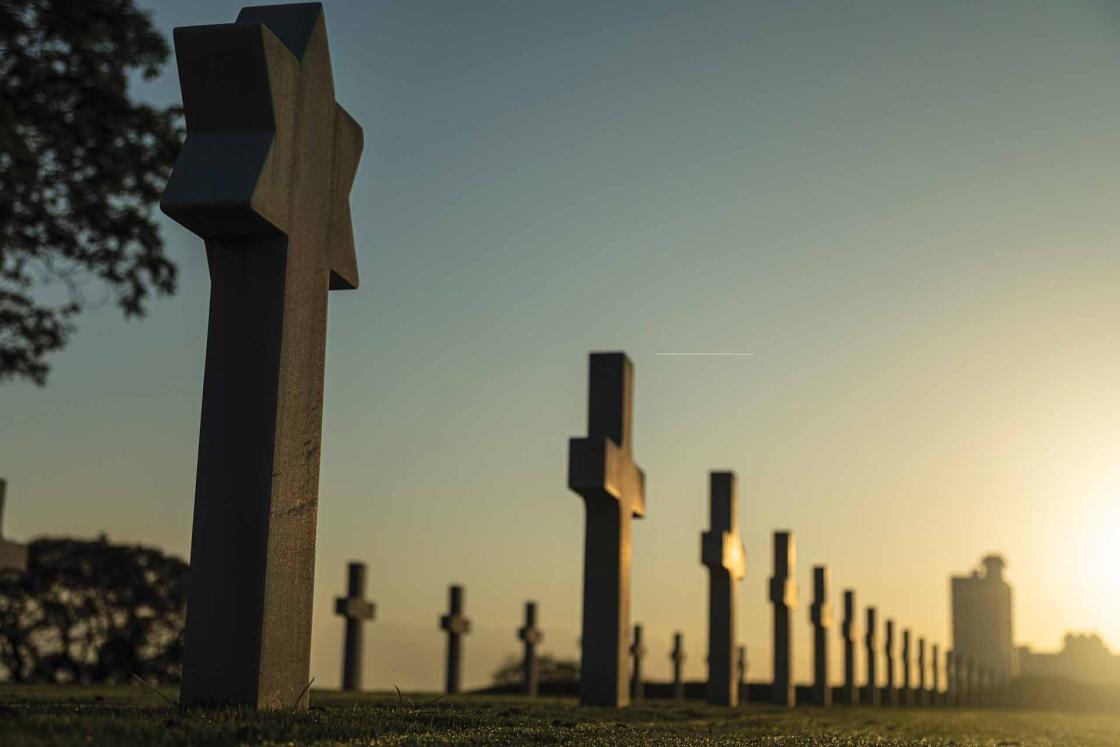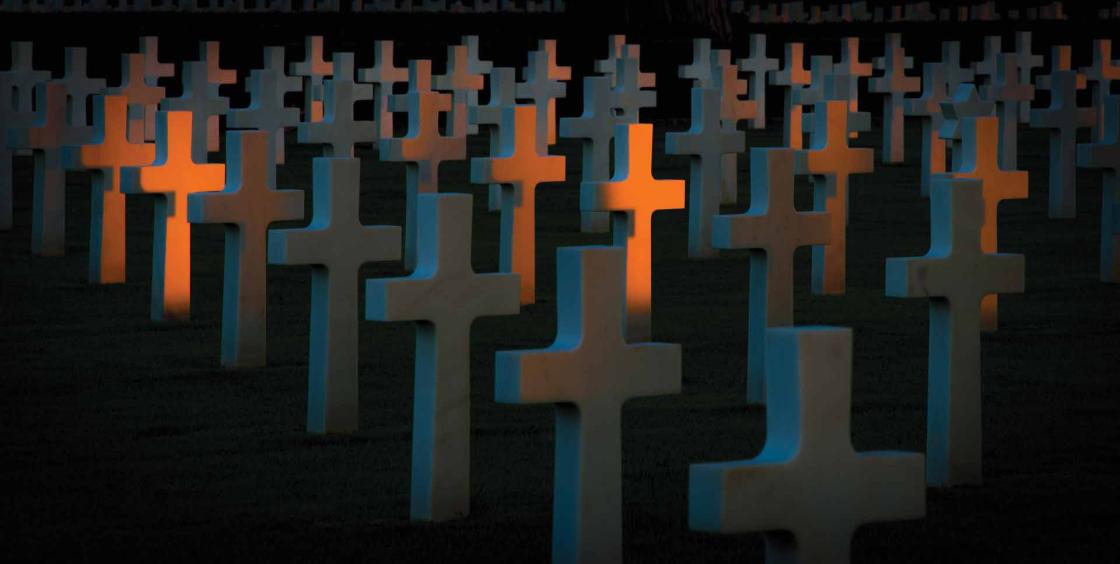Home of Heroes

Luxembourg American Cemetery, Luxembourg City, Belgium
The American Battle Monuments Commission (ABMC) is commemorating its centennial anniversary throughout 2023, reflecting on 100 years as the guardian of America’s overseas commemorative cemeteries and military memorials worldwide. Though a century has passed since the agency’s formation, its history is ever present.
For instance, U.S. Army Air Forces 2nd Lt. William J. McGowan was laid to rest in France this past July under the care of ABMC, nearly 80 years after he was killed during operations in World War II.
The 23-year-old Minnesota native perished on D-Day — June 6, 1944 — when the P-47 Thunderbolt he was piloting crashed while on a mission near the city of Moon-sur-Elle, France. While the crash site was initially investigated in 1947, his remains were declared non-recoverable. He was not officially accounted for until 2019, after the site was excavated and his remains were forensically identified.

McGowan’s family chose a burial at Normandy American Cemetery, alongside more than 9,300 other Americans who made the ultimate sacrifice. Though interments there are infrequent, as the cemetery was declared closed to new burials in 1956, individuals who are later recovered and identified can be laid to rest there at the family’s request.
“When we were asked where we wanted the final resting place of our uncle to be, we did not hesitate,” said Paul Stouffer, McGowan’s nephew.
As the organization commemorates its centennial anniversary, stories like McGowan’s showcase ABMC’s important legacy and continuous role in honoring those who fought and died in the name of freedom — even decades after their deaths.
“It is our mission to care for those individuals who gave their lives in service to our nation, no matter how many years have passed since they made the ultimate sacrifice,” said Scott Desjardins, Normandy American Cemetery superintendent. “It is our solemn honor to provide Lieutenant McGowan a final resting place among those he served beside.”

ABMC’s role was already solidified and solemnified during McGowen’s lifetime, having been created in the aftermath of what was then known as the Great War. Following World War I, the U.S. government recognized a need for a burial and repatriation policy for America’s war dead. Over the course of the conflict, more than 116,000 Americans lost their lives in Europe. Understanding the need to acknowledge America’s contribution to the war in Europe through commemorative cemeteries and memorials overseas, the government also respected the desires of many Americans to have their fallen family members returned to the United States. Under provisions of the law, families were entitled to select permanent interment of a loved one’s remains in an American military cemetery on foreign soil, repatriation of the remains to the United States for interment in a national or private cemetery or repatriation to the individual’s homeland. A majority of families chose repatriation, but approximately 40 percent opted for permanent interment overseas.
Recognizing the need for a federal agency responsible for honoring American armed forces where they had served overseas and for controlling the establishment of military cemeteries, monuments and markers on foreign soil, Congress created the American Battle Monuments Commission in March 1923. In 1934, ABMC was charged with maintaining American cemeteries and memorials abroad that honor fallen and missing U.S. service members of WWI, and eight permanent cemeteries were established to fulfill the mission.
Within a decade, ABMC’s role grew through tragedy as a new generation of Americans answered their nation’s call to service in another global conflict. By the end of World War II, several hundred temporary burial grounds had been established by the United States Army on battlefields around the world. In 1947, 14 overseas sites were selected to become permanent cemeteries by the secretary of the Army and ABMC. Twelve overseas monuments and three stateside memorials were also established.

“ABMC has proudly honored America’s fallen heroes for a century,” said ABMC Secretary Charles K. Djou. “Our promise is to carry forward the legacy of Lieutenant McGowan and all those buried or memorialized within our sites for the next one hundred years and for generations to come.”
The centennial anniversary highlights this evolution of ABMC’s mission. Its cemeteries include nonsectarian chapels, sculptures, battle maps and narratives depicting the course of the war in a region, as well as visitor reception facilities. Thus, not only is the agency focused on commemoration, but also on embracing the art, architecture and horticulture that together create the tranquil sites entrusted to its care.
These unique facets — the culmination of art as a commemorative tool — can be a bridge for new audiences to experience ABMC. For most of the agency’s existence, it has welcomed to its sites the family members and friends of the fallen — as well as local residents who share in the wartime history — to pay their respects to those who fought and those who were lost. With each passing decade and with such direct ties becoming fewer, it becomes more important to welcome new generations of visitors and develop ways of establishing a connection to the sacrifices that were made.
Today, ABMC operates and maintains 26 permanent American burial grounds and 32 separate memorials, monuments and markers on foreign soil and in the U.S. There are 124,000 American war dead interred in these cemeteries, of which 30,973 are from World War I and 92,958 from World War II. Additionally, the names of more than 8,200 individuals listed as missing from the Korean War and more than 2,500 individuals from the Vietnam War are memorialized at ABMC’s Honolulu Memorial. Elsewhere, more than 15,000 American veterans and others are interred in the Mexico City National Cemetery — which includes 750 unidentified dead from the Mexican-American War. All told, AMBC keeps more than 200,000 legacies alive at its sites spread across 17 foreign countries and the United States. Each of these sites is a tribute to service and sacrifice that must never be forgotten.

“The American Battle Monuments Commission is an agency of the American people,” said Djou. “This is our history and heritage, and connecting our past to the future and engaging with the next generations will help ensure the true cost of preserving our values and the American way of life continues to be shared and understood.”
At the time of its founding, General of the Armies John J. Pershing was appointed to ABMC’s board of commissioners and subsequently elected chairman. He served in that capacity until his death in 1948, when he was succeeded by Gen. George C. Marshall. All 11 veterans — 10 of them generals — to have held the post have lived out and perpetuated the vision articulated by Pershing: “Time will not dim the glory of their deeds.”
Learn more about AMBC, its history and centennial at www.abmc.gov.




